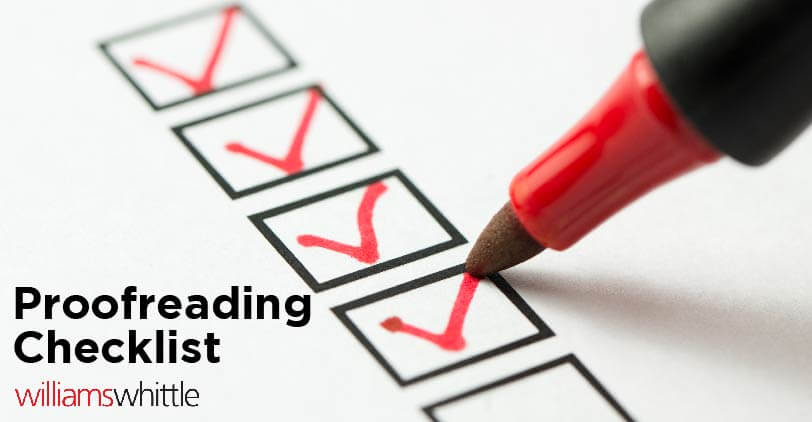In honor of National Proofreading Day, we started a conversation around the office on our proofreading horror stories to inspire a checklist to pass along to our future selves and other advertising professionals to help avoid these blunders happening another time.
To start- let’s review the difference between proofreading and editing. Proofreading is often viewed as the last step of the writing process. Editing is the first step in reviewing your writing and taking into consideration the overall flow and structure. After editing, comes the reason for today’s celebration- proofreading. This is the final comb through to review the grammar and mechanics of your writing.
Phone Numbers
If there is a phone number in your advertisement, pick up the phone and call it. Wouldn’t you rather catch a mixed number than let a potential customer, client or donor call that line and find out it is actually the number of a less than safe for work business?
URLs
Just like checking phone numbers, plug URLs into your browser and make sure everything loads as it was intended.
Prices
Double check all your facts and figures and make sure any prices you have listed are correct and updated. Our President, Kelly Callahan-Poe, recalls a time when the prices for burgers she was advertising on drive-thru signage didn’t reflect current pricing updates after thousands of these signs were debuted. The error had to be patched up with a sticker.
Lack of Cohesion
In advertising, we need to get our point across in as few words as possible. It can be difficult to convey your purpose with limited space. Sometimes this leads to a whole lot of run-on sentences as well as repeated words and unnecessary jargon.
Famed writer, George Orwell governed his prose with a few simple rules that included
“Never use a long word where a short one will do.”
“Never use a foreign phrase, a scientific word or a jargon word if you can think of an everyday English equivalent.”
These rules stand the test of time as great reminders that doing more with less is the way to go.
The Hemingway Editor is a great way to get rid of unnecessary jargon as well as an overabundance of adverbs and use of the passive voice. The tool will even check the reading level of your writing and point out words that could be simplified.
Fragmented Thoughts
The reverse of being too wordy can be omitting words or phrases that accurately finish your thoughts. During the proofreading process, it is vital to check for missing words and sentence fragments. It is easy to get caught up in a thought and finish a sentence in your head, but not on paper. To alleviate this, make sure all of your sentences have a subject and a verb. In addition, check to make sure that your dependent clauses have a matching independent clause to go with them. For example:
“That is why we need your support of this Fall’s fundraising drive.” This is a dependent clause that does not make sense on its own. If changed to “Each donation can feed a needy family, that is why we need your support of this Fall’s fundraising campaign.” The dependent clause now has an independent clause to explain the dependent clause and make an unfragmented sentence.
It can also help to read your work aloud to catch these errors more easily. If you find yourself in a quiet office or would rather listen to someone else read your work, Google Translate can do it for you. Paste the copy in the text box and click the speaker button. It can be helpful to hear your writing in a voice other than the one in your own head to more easily catch errors.
Swapped Content
Often times a similar advertisement may get reused for multiple campaigns, but not before important names and dates are changed to reflect the necessary refresh. Kelly shared with us about another time when the hotel she worked for and another nearby hotel were sharing advertisement space including showcasing their hotel’s specific rates. Each week they swapped the hotel who would be listed at the top of the page. One week the names and logos were switched but the rates were kept the same. This resulted in her hotel marketing the other’s rates, a less than ideal edit for that week’s version of the advertisement.
Legal or Disclaimer Jargon
If there is any fine print that needs to be added to your advertisement don’t forget to make sure that is remembered with as much importance as the snazzy new graphic you can’t wait to launch. Senior Account Executive, Glaelis Sierra-Gomez, recalls a time when a retail insert passed through multiple reviews without catching the omission of the legal disclaimer. This lengthy insert had to be completely reprinted.
Typos
Don’t just rely on spell check to catch your errors because it could miss those words that are spelled correctly, but are not the appropriate words for your ad. Our Chairman and CEO, Rob Whittle, says the proofreading mistake that haunts him is when an advertisement read ‘kitchen with panties’ rather than ‘kitchen with pantries.’
It can be helpful to read through your copy for one specific type of error at a time. Dedicate each pass through your writing to focusing on a specific type of error to avoid trying to catch too many mistakes at one time. Kelly believes that the more eyes that you can get on your copy the better. Consider having multiple members of your team sign off on your writing before it is published. This allows you to slow down the proofreading process a bit and allow other readers to help you catch the errors you may be missing.
We know that many advertising professionals have stories like ours that remind them to double and triple check their work. Feel free to download our checklist and tack it up in your office as a reminder when you are short on time to check for these potential writing blunders and we wish you error-free copy on this National Proofreading Day. If you are in need of assistance in crafting the perfect copy or someone to come alongside you in the advertising process please don’t hesitate to contact the Williams Whittle team.



